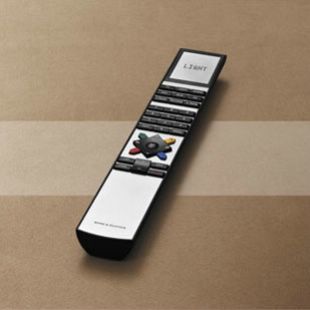Beo4 is the key to all current Bang & Olufsen television and music systems. A remote control must be able to be operated in the dark, without glasses and without moving your eyes from the screen. That’s why the most often-used controls on the Beo4 are gathered together on one multi-functional button which you can control with just your thumb: programme shift, video play and wind. Choose a function and your command is registered on the Beo4’s LCD display. Simple and logical, so the manual can be put away after a few days. The design is ergonomical and so tough that Beo4 can be left in the hands of the youngest user.
Beo4 Mark III Update – November 2004
Released in order to ensure that the remote control keeps up to date with products currently sold, as well as new products on the horizon, Beo4 Mark III was produced for sale at the end of 2004.
Visual changes were made to the V.TAPE, A.TAPE and SAT buttons and are now renamed V.MEM, A.MEM and DTV. A number of changes have also been made to the ‘LIST’ functions. The part number of the new remote is: 1162700
Beo4 remote control is provided with all new Bang & Olufsen TV receivers. It may be purchased as a separate accessory (around £155 – 2004 prices) to control audio equipment and lights. It works with all recent (post-1994) Bang & Olufsen products and also Beolink® around-the-house systems. It is one of the most powerful remote controls on the market; so much so, that the user needs not point it directly at the appliance being controlled.
The star-shaped control can be operated by your thumb alone – you don’t need to move your eyes to look to see what you’re doing. Extra ‘buttons’ can be programmed into the unit to control other not so much needed functions of Bang & Olufsen products.
Plastic-free surface on remote control units
“Surface treatment is very important to Bang & Olufsen. It affects not only the appearance but also the feel of a piece of equipment” states Technology Director Peter Petersen. “A product is created to be used, and you can’t do that without touching it.”
“A Bang & Olufsen terminal – or remote control – must sit nicely and comfortably in the hand. So we don’t coat it with plastic. A plastic terminal somehow doesn’t feel as genuine as ours. And gets hot and sweaty, too. After a great deal of work on the choice of materials we have selected zinc for all our terminals. It sits well in the hand and is pleasant to touch. The heat from the hand is conducted away, so the terminal never feels clammy. In design terms, this choice represents an extra form of quality.”
Bang & Olufsen terminals, of course, are not just attractive to the eye and pleasing to the hand. User interface is in fact one of Bang & Olufsen’s main concerns, where technology is really put in the service of humankind. Through logic operations, in fact, B&O’s remote control units make life with the product a pleasant experience.
Handing it intuitively to Bang & Olufsen: a history of remote controls
Bang & Olufsen’s first remote control came on the market in 1974. That year, Bang & Olufsen launched two products, each with a remote control of the same design. It was the size of a small cigar case and had a steel top plate. These two remote controls, which were not integrated, were the Beovision 6000 Commander and the Beomaster 6000 Commander. The TV remote control allowed the user to select programmes and picture quality from the comfort of an armchair. The remote control for the stereo enabled the user to control a four-channel sound system.
Before too long remote controls became smaller, in the form of Beovision 6002’s Beovision Control Module. The buttons on its surface were designed so that you could use the remote control without looking at it. Those for turning down a setting were shaped to curve downwards, while the buttons for turning up a setting curved upwards.
The following Video Terminal was cast in zinc so that heat was conducted away from the palm of the hand. This remote control, which used an infrared beam, was launched in 1980. It was quite narrow, with a keypad that both resembled and functioned the same way as the buttons on a telephone. This was another way of helping the user to operate the remote control without looking at it. This version introduced additional buttons for operating Teletext TV.
The following year, Bang & Olufsen added functions for operating video recorders and a new version of the Beovision Control Module. System integration had advanced to the point of sharing a remote control between the Beovision 8800 and Beocord 8800 Video.
The next generation of remote controls arrived when it became necessary to transfer more operating information that, for purely technical reasons, could not be incorporated into a single remote control. Now sound could be transferred between the television and the stereo system. This became possible with the combination of a video terminal and an audio terminal into an AV Terminal – the forerunner of Beolink 1000 – in 1985.
In 1987, all audio, video and audio/video remote controls were integrated into one unit with the Beolink 1000. Since then, Bang & Olufsen has pursued a strategy of only having one remote control for all products – most recently with Beo4, which is capable of operating all products. Beo1 is a minor exception to the strategy. It only operated Beocenter 1 and Beovision 1 and was intended for a new customer segment, which it did not completely succeed in capturing. For this reason, it was replaced by the Beo4 from autumn 2002.
Beo4 Specifications
In general, Bang & Olufsen’s development of remote controls can be summed up in a simple concept: Intuitive use. It is important to be able to adjust sound and picture from wherever you may be in the home. Accordingly, Bang & Olufsen has chosen simple functions – and that, of course, also has implications for the design of the remote control. It’s easy enough to pack a lot of buttons and functions into a remote control, but Bang & Olufsen has chosen a simple operational philosophy for the customer.
Beo4 has relatively few buttons, but it can retrieve a lot of information if required. That is what you call quality. Since the development of the first remote control cast in zinc, the company’s remote controls have had a certain intrinsic weight. This helps to give a sense of quality. Last but not least, the remote control is renowned for having a long range. You don’t have to get into a special position to communicate with the system. Once you have the remote control in your hand, you are ‘in total command’.
(Taken from Beolink Magazine: ‘The First 50 Years of Television’ © Bang & Olufsen a/s 2002)







